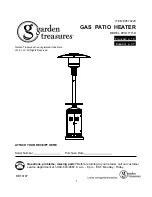
Page 5
ENGLISH
Installation and Operation Manual
|
Jandy® Legacy™ Model LRZE Pool/Spa Heater by Zodiac®
Section 1. General information
1.1
introduction
This manual provides installation and operation
instructions for the Legacy Model LRZ electronic
pool and spa heaters. Read these installation and
operation instructions completely before proceeding
with the installation. Consult the factory, or local
factory representative, with any questions regarding
this equipment.
Certain sections of this manual are specific to
either United States or Canadian installations, and are
labeled as such.
The Legacy Model LRZ electronic heater gets
electrical power from an external 120VAC or 240VAC
source and provides a dual electronic thermostat
control system for pool/spa combinations or preheat
convenience.
The Legacy Model LRZ electronic heater
is specifically designed for heating fresh water
swimming pools and spas, and with proper installation
and care, they will provide years of reliable service.
Do not use the heater to maintain pool or spa water
temperature below 70°F (21°C). Do not use it as a
heating boiler or general service water heater or to
heat salt water. Consult your dealer for the appropriate
Jandy products for these applications.
note
“Fresh water swimming pools and spas”
include systems that utilize saltwater chlorine
generator units, such as the Jandy AquaPure
®
Electronic Chlorine Generator. Please ensure
that the salt content of the pool/spa
does not
exceed
4000 ppm and water flow rate is within
30-125 gpm (110-475 lpm).
1.2
consumer information and Safety
The Legacy Model LRZ electronic heater is
designed and manufactured to provide many years of
safe and reliable service when installed, operated and
maintained according to the information in this manual
and the installation codes referred to in later sections.
Throughout the manual safety warnings and cautions
are identified by the " " symbol. Be sure to read and
comply with all of the warnings and cautions.
1.2.1 Spa/Hot tub Safety Rules
WaRninG
The following “Safety Rules for Hot Tubs,” recom-
mended by the U.S. Consumer Product Safety
Commission, should be observed when using the
spa.
aVeRtiSSeMent
Les Règlements suivants pour Cuves Thermales,
tel que recommandés par la Commission U.S. de
Sécurité des Produits pour les Consommateurs,
devraient être respectés lors de l’utilisation du spa.
WaRninG
The U.S. Consumer Product Safety Commission
warns that elevated water temperature can be
hazardous. Consult heater operation and installa-
tion instructions for water temperature guidelines
before setting temperature.
aVeRtiSSeMent
La U.S. Consumer Product Safety Commis-
sion indique que des températures de l'eau
élevées peuvent être dangereuses. Voir la notice
d'installation et de fonctionnement pour le réglage
de la température.
1. Spa or hot tub water temperature should never
exceed 104°F (40°C). One hundred degrees
Fahrenheit (100°F [38°C]) is considered safe for
a healthy adult. Special caution is recommended
for young children.
2. The drinking of alcoholic beverages before or
during spa or hot tub use can cause drowsiness
which could lead to unconsciousness, and subse-
quently result in drowning.
3.
Pregnant women take note!
Soaking in water
above 102°F (38.5°C) can cause fetal damage
during the first three months of pregnancy (which
could result in the birth of a brain-damaged or
deformed child). If pregnant women are going
to use a spa or hot tub, they should make sure
the water temperature is below 100°F (38°C)
maximum.
4. The water temperature should always be checked
with an accurate thermometer before entering a
spa or hot tub. Temperature controls may vary by
as much as 1F° (1C°).
5. Persons with a medical history of heart disease,
diabetes, circulatory or blood pressure problems
should consult their physician before using a hot
tub or spa.
6. Persons taking any medication which induces
drowsiness (e.g., tranquilizers, antihistamines, or
anticoagulants) should not use spas or hot tubs.
7. Prolonged immersion in hot water can induce
hyperthermia.
Hyperthermia occurs when the internal body
temperature reaches a level several degrees above the
normal body temperature of 98.6°F (37°C). Symptoms
include dizziness, fainting, drowsiness, lethargy, and
an increase in the internal body temperature. The
effects of hyperthermia include:
•
Lack of awareness of impending hazard
Summary of Contents for LRZ Electronic
Page 2: ......






































